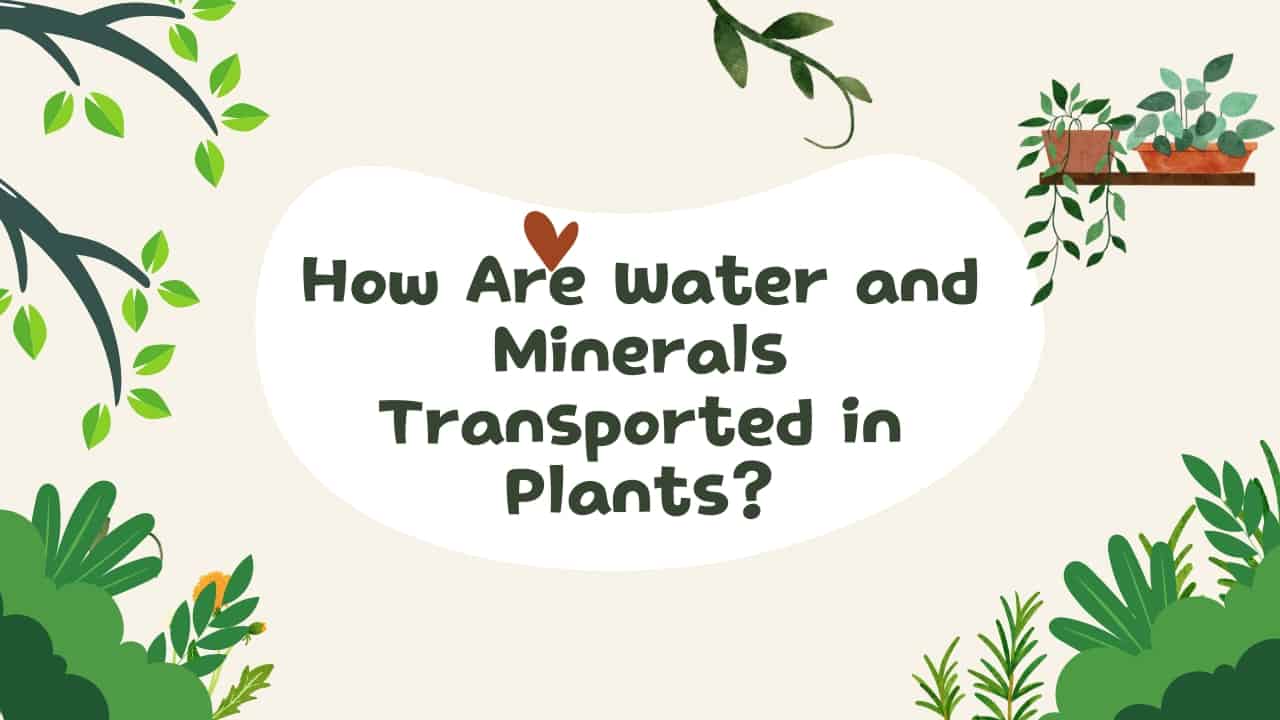The transport of water and minerals is crucial for plant growth, development, and survival. Water serves as a conduit for nutrients to be transported as well as a solvent for biological activities.
Plants require minerals, which are inorganic nutrients, for metabolic processes such as growth and reproduction. Specialized tissues powered by transpiration, such as the xylem and phloem, assist the movement of water and minerals.
The ability of plants to transport water and minerals is crucial for crop output, water usage effectiveness, and fertilizer control.
Process of Water and Minerals Transported in Plants
To better understand how plants efficiently acquire and distribute resources, this writeup will examine the mechanisms involved in water uptake, the transport of water and minerals in the xylem, the translocation of organic molecules in the phloem, and the factors influencing these processes.
1. An Overview of the Plant Vascular System:
A. The Xylem and Phloem’s Structure and Function :
The two types of plant vascular tissues, xylem, and phloem, which are in charge of transporting water and nutrients, are briefly described in this subheading.
B. Importance of Water and Mineral Transport:
This section highlights the significance of water and mineral transport in plants, emphasizing their function in growth, nutrient uptake, and general plant physiology.
2. Water Absorption and Uptake:
A. Root Hairs and their Function in Water Absorption:
This subheading aims to highlight the role that specialized root hairs play in expanding the surface area of roots and facilitating effective water absorption.
B. Osmosis:
Movement of Water into the Root Cells: Explains how water can enter the root cells by moving from an area with a greater water potential to one with a lower water potential.
C. Guttation and Root Pressure:
This section discusses guttation, or the exudation of water droplets from the margins of leaves, as a result of guttation and how it is caused by the phenomena of root pressure and its effect on water transport in plants.
D. Capillary Action and Cohesion-Tension Theory:
This section investigates the mechanics underlying capillary action and cohesion-tension theory, which describe how water is transported through the xylem and up to the top of the plant.
3. Water Movement in the Xylem:
A. Transpiration:
Loss of Water via Stomata: Describes the mechanism by which water is lost from plants through tiny pores known as stomata on the leaf’s surface.
B. Cohesion and Adhesion in the Xylem:
This section discusses water’s cohesive and adhesive qualities that help it move through the xylem and enable the continual upward flow.
C. Root Pressure and its Contribution to Water Movement:
This section examines how to root pressure influences water movement in the xylem, especially in certain plant species and under particular circumstances.
4. Mineral Absorption and Uptake:
A. Mineral Absorption and the Role of Roots and Root Hairs:
Examines the specialized root structures, including root hairs, that improve the surface area for effective soil mineral ion absorption.
B. Mineral intake against Concentration Gradient:
This section discusses the active transport method, which involves plants using energy to move mineral ions against a concentration gradient to ensure the intake of vital nutrients.
C. Mycorrhizal Symbiosis and Enhanced Nutrient Absorption:
Discusses the mutualistic association between plant roots and helpful fungus known as mycorrhizae improves the plant’s capacity to absorb nutrients, particularly phosphorus.
5. The Xylem’s Mineral Transport:
A. Ion Movement and Loading into the Xylem:
This section investigates how mineral ions are absorbed by the roots and loaded into the xylem vessels for long-distance transportation.
B. Long-Distance Transport through the Xylem:
Discusses the water and dissolved minerals travel upward in the xylem vessels from the roots to the aerial regions of the plant, delivering nutrients to all tissues.
C. The Importance of Transpiration in Mineral Transport:
Explains transpiration, the loss of water vapor through the stomata, provides a negative pressure that aids in the movement of minerals up the plant alongside the water.
D. Xylem Sap and its Composition:
Explains the elements that makeup xylem sap, which is essential for a plant’s growth and metabolism. It contains water, minerals, hormones, and other compounds.
6. Sugar Translocation in the Phloem:
A. Source-Sink Relationship in Sugar Translocation:
This section examines the idea of a source-sink relationship, in which sugar-rich sources, like leaves, provide sugars to sinks, such as growing tissues or storage organs, which are sugar-poor.
B. Photosynthesis and Sugar Production:
This section discusses light energy, carbon dioxide, and water are used to create sugars, primarily sucrose, in leaves.
C. Phloem Loading and Unloading:
This section describes sugars loaded into phloem sieve tubes in source tissues and emptied in sink tissues for use as energy or storage.
D. Pressure Flow theory:
This section describes the pressure flow theory, which explains the pressure produced by sugars moving causes them to move through the phloem.
7. Water and mineral transportation regulations:
A. Stomatal Regulation and Control of Transpiration:
Plants control transpiration by opening and closing their stomata to prevent excessive water loss and maintain a balanced level of water in the plant’s tissues.
B. Hormonal Influence on Water Uptake and Transport:
This section examines plant hormones, such as cytokinins and abscisic acid, which control how much water plants take in, how their stomata behave, and how they transport water throughout their bodies.
C. Environmental Factors Affecting Transport Processes:
This section discusses environmental variables like light, temperature, humidity, and soil conditions that affect how plants transport water and minerals.
Conclusion:
Plants’ ability to transfer water and minerals is crucial to their development, absorption of nutrients, and general health. The flow of water and minerals is greatly aided by the plant’s vascular system, which comprises the xylem and phloem. By comprehending these transport pathways, we can better grasp the complex mechanisms that sustain plant life and ensure its survival in various environmental situations.
Also Read:
